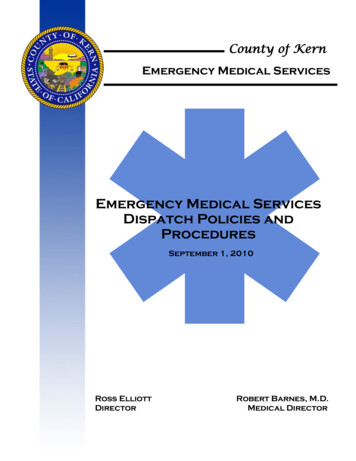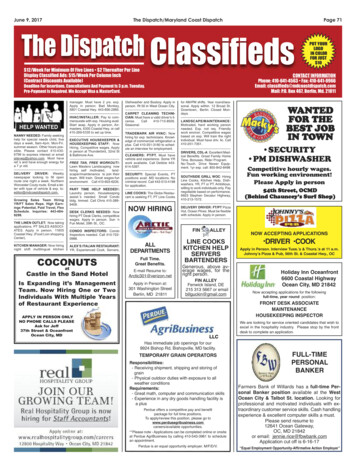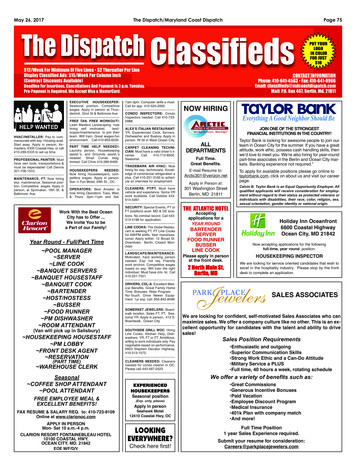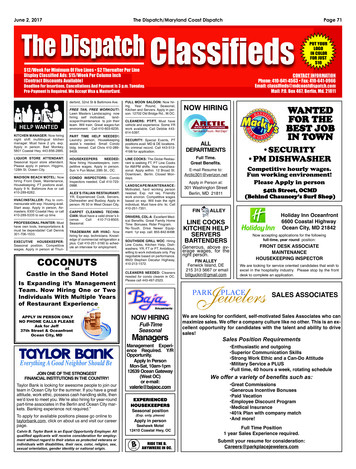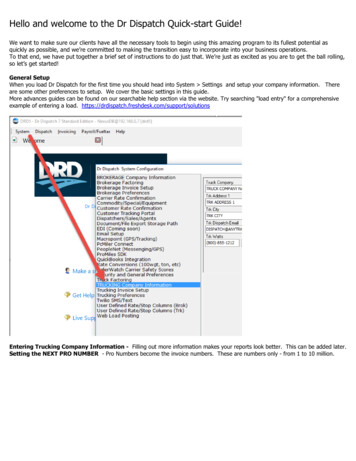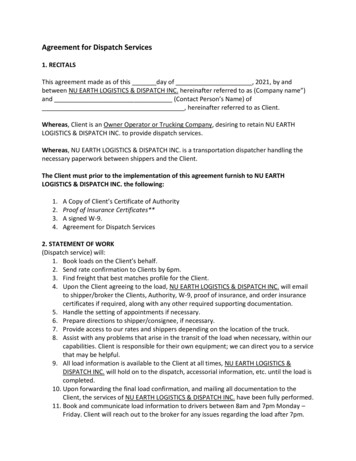
Transcription
TheBrandywineDispatchSUMMER 2022History Lives at Colonial Days!We are happy to announce that Colonial Days is once again being presented at the Brandywine Battlefield Park, following two years of remote programming. Students attending area school districts have returnedto the Park to actively participate in Colonial Days, a keystone education program provided by the BrandywineBattlefield Park Associates.Shelia Bliss, Education Program Coordinator, supervises the program and supports the volunteer presenters for each program component. Volunteers are dressed in period costume appropriate for the specificdemonstrations. Colonial Days content provides unique insight into life in the 18th century, particularly in theQuaker dominated Brandywine Valley. The Battle of the Brandywine and the challenges faced by the Continental Army are presented by historicalreenactors.Read a Letter,Write a Letter-Writingin the 18th Century” Students make paThe Colonial Garden The historic yardper and experience writing with a quillgarden is planted next to the Ringand ink as they learn the importance ofHouse. Students learn about the plantscommunication through letter writing inand herbs used for medicines andColonial America.housekeeping issues, as well as forcooking and food.18th Century Blacksmith” the “Smithy”thand his Striker (apprentice) fire up the18 Century Carpenter Students experiforge and “strike while the iron is hot.”ence the craft of the carpenter as theyStudents learn about being an apprenlearn about the importance and contritice of this skilled craft and the history,bution of a skilled carpenter throughtechnology, techniques, and economicthe use of woodworking tools.importance of this vital trade.Life of a Soldier “Ned Hector” ( interMedicine in the American Revolution”preted by Noah Lewis) fought at theColonial medicine, treatments, proceBattle of the Brandywine, shares hisdures and how plants from the historicpersonal story and the life of a contigarden were processed and used tonental soldier.treat a variety of ailments are presented.Mario the Carpenter presents 18thCentury Carpentry to studentsLife of a Quaker Family This program demonstrates the lifestyle of a Quaker family living in the BrandywineValley during the battle, how a Quaker family lived, worked and played at the Gideon Gilpin House located atthe Park. The cultural beliefs of the Quakers are compared to modern beliefs and lifestyle and addresses theimpact the Battle of the Brandywine had on the Quaker community.Additional segments include “What’s Old, What’s New;” “A Revolutionary Soldier Dress-Up” can be included in “Life of a Soldier;” “A Quaker Girl Dress-up” can be included in “Life of a Quaker Family” and“Colonial Dancing.”The Brandywine Dispatch is the newsletter for the Brandywine Battlefield Park.The Brandywine Dispatch is published by the Brandywine Battlefield Park Associates.“Keeping the Story Alive and Interesting!”
Page 2The President’s ViewBoard of DirectorsLinnell E. TrimbellPresidentGeorge ThorpeVice PresidentTheresa CeulersVice President / SecretaryShirley D. DoganTreasurerDirectorsPeter AdamsCarly BeehlerEric DownsAlexis FurlongStaff Personnel:Shelia BlissEducation ProgramCoordinatorNancy HeitzenreiterBusiness Services CoordinatorBrett PattersonControllerJesse WolfeEducation & Tech ServicesTroy GrubbSite AdministratorKen LevinPHMC Maintenance“Membership, the Core of Our Organization”: The Brandywine Battlefield Park Associates (BBPA), established in 1971 (circa) was established as, and is, a Membership based organization. The non-profitBylaws focus is on membership for fundamental structure. Essentially, BBPA was established as an adjunct to support the Pennsylvania Historic and Museum Commission(PHMC) and tasked as trusteeto administer the Brandywine BattlefieldPark (BBP) for the citizens of the Commonwealth of Pennsylvania. BBPA is the “armsand legs” or the Worker bees. BBPA hasvaliantly assumed this role, which haschanged over time. BBPA can accomplishthings which our partner PHMC cannot.BBPA develops and recruits Volunteers forEducation Programs, as well as major events. Looking at a lineargraph illustration of the BBPA organization, one can visualize a series of concentric circles. Membership is central at the core of the circle. Membership is our heart and soul of the BBPA Organization encompassing the membership of individuals and families.Why be a member? support enthusiasm and interest. provide for the vital human capital of volunteers. people who become members are involved and feel positiveabout their inclusion with this historic community and the community at large.In closing, my mission for the next year is encourage, develop andgrow membership. Please join me on this crusade!Submissions are Welcome!Mail to:Newsletter EditorBrandywine Battlefield ParkAssociatesP. O. Box 202Chadds Ford, PA 19312610-459-3342Email Submissions to:bbpaorgcommunications@gmail.comRegards,Linn (Linnell) TrimbellPresident, Board of DirectorsBrandywine Battlefield Park AssociatesPlease visit our website for more information aboutMembership and to become a Memberwww.brandywinebattlefield.org
PPage 3The Brandywine DispatchPage 3History ChallengeODD MAN OUTWhich of these does not belong?During the battle of Brandywine, Gen. Washington had to contend with several crossings onthe Brandywine Creek. Which of these was not one of them?BuffingtonWistar’sDarlington’sJonesIn the American Revolution, there were numerous Officers with whom Gen. Washington relied on. Who was not one of them?Nathaniel GreenePhilip SchuylerJohn SullivanHenry ClintonThere were many spies in the American Revolution. One of these was not one of them.Caleb BrewsterRobert MorrisNathan HaleAustin RoeAnswers on page 6 Words that are common today often had completely different meanings in Colonial America.Here are a few:Anchor- (n) A frequent misspelling of anker, about 10 gallons. In 1719, William Byrd admitted that: “a smuggler brought some brandy and I bought two half anchors.”Banker- (n) A man or ship that fished the Newfoundland Banks. A 1710 Boston newspaperreported: “A French Banker of fourteen guns, laden with fish, arrived there from Newfoundland.”Factor- (n) An agent. From Latin. A 1742 letter from New York to the Board of Trade said,“Trade from Holland is carried on by factors here for the sake of their commission.”Hammock- (n) (1) A small hill. In 1709 John Lawson instructed, “Steer W.N.W. the Eastpoint of Bluff-Land at Hatteras bearing E.N.E. the Southermost large Hammock toward Ocacock.” (2) A piece of land suitable for hardwoods. In 1756 John Bartram wrote, “The hammocks of live-oaks and palmettos are generally surrounded either with swamp or marsh.”Nappy- (n) A frothy ale. Probably because its head was nappy, frothy. A 1728 song extolled:“a jug of brown Nappy.”
The Brandywine DispatchPage 4Site Administrator’s ReportSpring is in full swing, and there has been a flurry of activityat the site since I last communicated with everyone. Since ouropening and particularly over the last few weeks, we’ve seen a largeinflux of people. In addition to our regular tours, we’ve conducteda few scheduled tours with both adult and school groups. Highlights have included repairing and replanting our colonial yard garden thanks to the hard work of some dedicated volunteers.Our house guides: Mark, John, Nick, and Fred have provided our visitors with numerous tours of the Ring and Gilpin homes.Some of these tours have ranged from two guests to as many as forty. I’ve conducted a couple of tours myself and have enjoyed seeingthe interest and enthusiasm for our site, its occupants, and the subject matter. One couple, all the way from California, made it a point to visit the site because the wife is a direct descendant of Benjamin Ring. Another group,the Retired Military Officer’s Association – Valley Forge Chapter, of which our own Fred Magner is a member,visited the site and were impressed by the beauty of the site and by Fred’s knowledge of colonial history.Colonial Days was presented at the Park for the first time since 2019. Our largest group consisted of 360students with accompanying chaperones. Of those five schools, four were colonial day programs. In addition tothe Colonial Day component programs, students also visit the historic houses, the visitor’s center for the film, giftshop, and museum. During one of these programs, we were assisted by the 1st Delaware Regiment, who discussed civilian life during the colonial period.Highlights have included repairing, preparing and replanting our colonial yard garden thanks to the hardwork of some dedicated volunteers. Our gardening group of Stevie DeMott, Carol Tynan, Mario Lerario, LinnTrimbell, and Robin Baker have been busy clearing the garden of the irrepressible weeds and planting herbsused for cooking, aromatics, medicine, and other household purposes. When you visit the park, you’ll noticethat the beds are color-coded with green highlighting the cooking herbs, white for aromatics, red for medicinalherbs, and blue for household use. Some of these herbs have multiple uses. For instance, lemon balm is an aromatic as well as a household herb and can be used in potpourri and as an insect repellent.Finally, I want to mention the new faces you may see at the park. Sheila Bliss has filled our EducationProgram Coordinator position, which was vacant after the departure of Andrew Outten. Sheila brings a wealthof experience as an educator at several area schools, working primarily with elementary age students. Amongher duties, Sheila will be creating and developing educational programs as well as coordinating with teachers andother educational organizations. She is already a master at the art of papermaking for our colonial day program.Thanks to all our volunteers for their hard work and dedication to Brandywine Battlefield Park. Ourcontinued and sustained growth is largely due to your efforts. I also want to thank all our members and contributors for your financial gifts and for promoting our site. Thanks again and have a great rest of your spring andsummer.Troy GrubbPHMC Site AdministratorBrandywine Battlefield ParkOPEN- Tuesday-Thursday 10:00 a.m.-4:00 p.m.Gates Open-Passive recreation on Park groundsFriday and Saturday 10:00 a.m.-4:00 p.m.Visitor Center Open Tours AvailablePlease check the website for updates!
The Brandywine DispatchPage 5The Colonial Kitchen GardenThroughout the Spring I toiled in the gardens. I cleared the winter debris, prepared, amended, dug holes,planted and watered. Everything looked perfect-for about two days. Now I sit in the gardens and wonder atthe explosion of frenzied growth from wanted plants and weeds alike. Two questions come to my mind:Where did that 5 foot thistle come from?andHow did the Colonial gardeners ever manage?The Colonial garden wasn’t just for vegetables. It was a larger space than the door garden and surrounded bya fence to keep the wildlife from damaging the crops. The size of the garden depended on the size of thefamily. The success of their gardens was literally a matter of life and death. Not only did the gardens providemuch wanted fresh produce during the growing season, the gardens also provided the crops to be harvested and preserved for use during the winter months.Trellis for beansGarden space was at a premium so plants requiring more space were grown onsouthern facing slopes. This included potatoes, pumpkins, squash, gourds andIndian ground nuts. Some of the crops in the garden included corn, lettuces, radishes, onions, cucumbers, beans, cabbage and peas. Fruit trees, primarily appleand pear, were planted near the garden fence. The Colonialspracticed companion planting. Squash, maize and climbingbeans are known as the Three Sisters (of agriculture). Mounds of soil with flattened topswere built for each group of crops. In the center of each mound several maize seeds wereplanted. When the maize reached 6" tall, beans and squash were planted alternatelyaround the maize. The beans used the maize as a structure to climb up and also providedthe nitrogen needed by the other two plants. The squash acted as a groundcover that reduced weeds andretained moisture. Additional beans were trained on poles or a trellis.Pests were a threat to the health of the garden. Colonial gardeners planted a variety of herbsamong their food crops to deter the pests. Onions were planted between the cabbages to confusethe bugs-companion planting. Garlic was planted to repel aphids, cabbage moths, bean beetles,peach borer and rabbits, and mint was planted to repel aphids, cabbage moths, flea beetles, squashbugs, whiteflies, and even ants.April 2022June 2022The Benjamin Ring House Door Garden restored and ready for visitors.
The Brandywine DispatchPage 6Interview with Shelia BlissShelia joined the BBPA family in May, 2022 as the Education ProgramCoorinator.Editor: Welcome Shelia! What initially triggered your interestin the Education Director position, the Brandywine Battlefield ParkAssociates and the Brandywine Battlefield Park?Shelia: I have a deep love for history and an even deeper love for educatingand invoking a passion in 21st century students about 18th century life. Welive in an area of immense historical gravity, and I would like to see moreschool districts foster a profound appreciation for the significance of thehistory of our township.Editor: How have your past experiences/field of study prepared youfor this position?Shelia: I am a retired schoolteacher. I have twenty-two years of classroomexperience. I have a B.S. and an M.Ed. in Elementary Education, Level I and Level II certification. I have taughtsixth grade, kindergarten and preschool.Editor: Where do you find inspiration for the work you are performing with the education programs?Shelia: Troy and Linn have been fundamental in terms of guidance, support and inspiration but ultimately asEducation Director, my inspiration comes from the children. Witnessing children bridge connections between the pastand the present is inspiring and motivating to me.Editor: What do you see as the most rewarding part of your position?Shelia: When a student on a field trip says to me, “I can’t wait to go home and tell my mom what I learned” I considerthat a rewarding and successful day. When a child finds meaning and association between the past and the present andcan scaffold his learning of prior knowledge into a new pathway of assimilation it makes my work at BBP truly validand full of purpose.Editor: What would you like to accomplish as the Education Director, both short term and long term?Shelia: Regarding short term goals, I am looking forward to learning everything I can about the history of the park andthe community as well as familiarizing myself with BBP’s wonderful programs. I am especially excited aboutre-establishing the summer camp programs. Regarding long term goals, I am very excited about being a part ofBrandywine Battlefield Park Association and building long lasting relationships with the community as well as mycolleagues.Shelia: I am a graduate of Penn State University and Widener University. I have been married to my highschool sweetheart, Rick Bliss, for twenty nine years. I live in Concord Township in Glen Mills. I have three beautifulsmart children. Ciara who is twenty-four and finishing up her degree in Criminal Justice at West Chester University.My daughter Zoe, who is twenty-two and finishing up her degree in Design Studies at West Virginia University andmy son Lucas, who is nineteen and transferring from Canada to study History and Computer Sciences.History Challenge Answers from page 3: #1 Darlington's, #2 Clinton, and #3 Robert Morris.OUR MISSSION“To preserve, interpret and share the impact of the enduring story of the Battle of the Brandywine, the largest single day land battle of the American Revolution.”
The Brandywine DispatchPage 7Volunteer Spotlight18th Century CarpentersJohn Gras (right) has served as“John the Carpenter” for manyyears and shared his time,knowledge and talent withthousands of students. John isnow “passing the tools” to Mario Lerario who is now knownas “Mario the Carpenter.”Mario has already presentedthe 18th Century Carpenterprogram to hundreds of students during the Colonial Daysprograms. Thank you Johnand Mario!Roy Steward(1949-2021)Roy was a benefactor Member. He volunteered at thePark for BBPA Events andSpecial Board Projects. Healways enjoyed helping atthe Battlefield whenever hecould. Roy served in theUnited States Army SpecialForces and earning his GreenBeret from 1969 to 1972.Roy graduated from TempleUniversity in 1976 with hisdegree in electrical engineering and was a very accomplished engineer. Roy passedaway in August, 2021 andwe miss his great smile, willing hands and kind heart.If you are interested in becoming a volunteer at the Brandywine Battlefield Park or know someone who might, please visit our website for more information and to fill out a registration irector@gmail.com“The Brandywine Battlefield Park Associates is a nonprofit 501(c)(3) organization, EIN #23-2143174. Theofficial registration and financial information of theBrandywine Battlefield Park Associates may be obtainedfrom the Pennsylvania Department of State by calling tollfree, in Pennsylvania, 1-800-732-0999. Registration doesnot imply endorsement”P.O. Box 202Chadds Ford, PA 19317610 / 459 - 3342Fax: 610 / 459 - 9586bbpaorgcommunications@gmail.com
Colonial Days was presented at the Park for the first time since 2019. Our largest group consisted of 360 students with accompanying chaperones. Of those five schools, four were colonial day programs. In addition to the Colonial Day component programs, students also visit the historic houses, the visitor's center for the film, gift shop, and .


